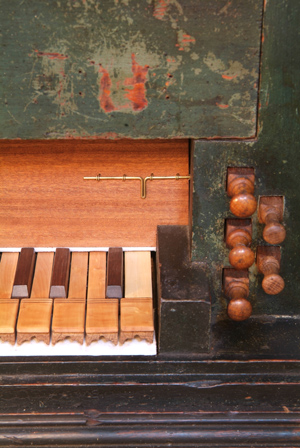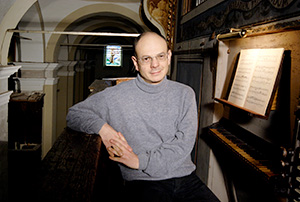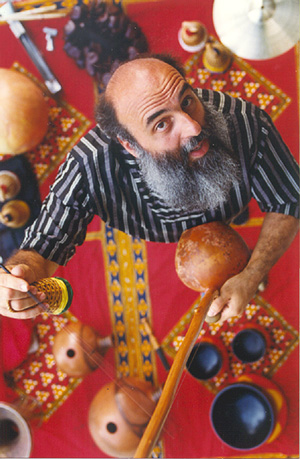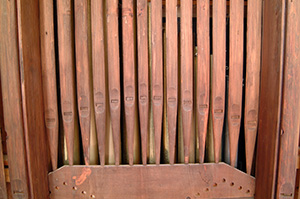 Sunday, 20 October, 6.00 p.m.
Sunday, 20 October, 6.00 p.m.
Church of Nossa Senhora da Luz
Monday, 21 October, 9.30, p.m.
Hospice of Bom Jesus
Giovannimaria Perrucci: organ
Peppe Consolmagno: voice and percussion
Elizabethan England is certainly one of the most fascinating periods in European cultural history. In the theatre the time of Shakespeare and Marlowe, but also of extraordinary music, such as that found in the Fitzwilliam Virginals Book, which contains music by Gibbons, Byrd, Farnaby and Bull. Fascinating music of great charm and character, this kind of composition is characterized by refined contrapuntal material and, at the same time, a remarkable melodic vitality, demonstrated particularly in the compositions based on popular themes.
The idea of this concert is to combine the rigour of the musical style of the so-called English virginals school with the spontaneity and extemporization typical of the Elizabethan theatre, inspired by William Kemp, actor, clown, musician and dancer in Shakespeare’s most important works. In order to achieve this difficult balance, the idea has also been not only to take into account the philological recovery of combinations of the probable timbres of the period, but also the experimental sounds of Peppe Consolmagno, who participates freely with his world instruments (thanks to his musicological research carried out in South America, Africa and Asia) and with the voice.
The carpet upon which Peppe Consolmagno places his instruments seems like a workshop of rhythms and sounds, a free space for the cacophony of the modern world dedicated to the pleasure of sound. Peppe Consolmagno builts sound objects for himself and for Nana Vasconcelos, one of his many admirers. The majority of these objects are made of materials gathered during his travels throughout the world, while others are imagined, combining his voice and the symphony of timbres and colours arising from this singular orchestra made up of one person: great gourds made into water drums, a Burmese gong, African earthenware pots, Pigmy flutes and much else. Some instruments come from the most heterogeneous traditions, such as those of South America, Africa, Asia and imaginary regions, and others are completely original, or reinvented. An acclaimed musicologist, a brilliant organizer of seminars and workshops, Peppe Consolmagno builds his performances as brief tales in a deliciously magical dimension.
Giovannimaria Perrucci and Peppe Consolmagno
Anónimo (Inglaterra, séc. XVI)
La bell Fyne
Arthur Phillips (1605-1695)
A Ground
Orlando Gibbons (1583-1625)
Fantasie
Hug Aston (1480-1552)
A Hornpype
Orlando Gibbons
Italian ground
John Bull (1562-1628)
In Nomine
Henry Purcell (1659-1695)
A Ground
Anónimo (Inglaterra, séc. XVI)
Upon La Mi Re
Henry Purcell
Rondó
Participants
|
Studies organ, harpsichord and composition at the Rossini Conservatory in Pesaro, subsequently continuing his studies in France, in the class of Xavier Darasse (organ) and Jan Willem Jansen (harpsichord) at the Conservatoire National Superieur de Lyon. He has given concerts, as soloist and in collaboration with soloists and ensembles, in festivals throughout Europe. He has recorded for RAI, Radio Monetebeni and Hessicher Rundfunk in Frankfurt. He has recorded CDs for Discantica (Milan), Bongiovanni (Bologna), Clavis (Rome) and Opera 3 (Madrid). Interested in the heritage of the Italian historical organ, he has contributed to the inventory of historical organs of the Region of the Marche, financed by the Marche Region, and is currently vice-president of the organists’ network Marche & organi. He is the author of texts on the organs of that region, including the catalogue of historical organs in some dioceses of the Marche, and a text for the Institute of Historical Italian Organs in Rome. He also prepared the modern edition of keyboard works by Francesco Basilj (1765-1850) and organ works by Mezio Agostini (1875-1944). He teachers at the G. B. Pergolesi Conservatoire in Ancona, at the Diocesan Institute of Sacred Music in Fano, and is organist of the Basilica of St Paternian in the same city. |
|
Peppe Consolmagno was born in Rimini in 1958, and grew up in Italy. In general he makes use of instruments he has himself built, with materials collected during his travels, such as gourds, bamboo, wood and metal. His music expresses itself through instruments from cultures from outside Europe, such as that of Brazil (his chief source of inspiration), Africa and Asia, but which have a common language. The Burmese gong, the shell, mediation bowls, African vases, the Pygmy single-note flutes, water drums and the didgeri-doo, united with his voice and the intimate relationship they have with each other, create a unique dimension in which natural sound, silence, timbre and rhythm predominate. Consolmagno writes for specialist periodicals and magazines such as "World Music", "Percussioni", "Strumenti Musicali", "Jazz", "DrumClub", "Il Manifesto", "Jazzitalia", "CiaoJazz", "CupaCupa", "Musicando" and others. He was invited, as the only European, to go to Salvador-Bahia for the 3rd and 4th Perc Pan (World Panorama of Percussion). Through his work as a journalist and his interviews with famous musicians, he aims to disseminate the style and way of thinking that he has in common with these artists. He has collaborated in other artistic forms such as theatre, painting, sculpture, poetry and dance. He has given seminars in university and schools, and has participated in radio and television programmes. |
Notes about the Organ
|
This instrument is a positive organ installed in the choir gallery. It was made by the builder Filipe da Cunha, who constructed it in 1760 in Lisbon, according to the inscription on the interior of the lower windchest. Although there have been minor repair works, the instrument has largely retained its original character and was restored in 2005-6 by the master organ-builder Dinarte Machado who restored it to its original pitch and temperament, as well as the original system for supplying wind. Manual (C, D, E, F, G, A-d’’’) |
 Hospice Bom Jesus, Funchal
Hospice Bom Jesus, Funchal
This small positive organ was built in 1781 by Leandro José da Cunha (b. 1743, d. after 1805), who was from Lisbon and was one of the three members identified as belonging to this family of organ builders. Leandro was the son of the builder João da Cunha (b. 1712, d.1762), also from Lisbon, who built the organ of the Church of Nossa Senhora da Luz, at Ponta do Sol.
It is an example of a type of instrument typical of Portuguese organs in the first half of the 18th century. The fact that the instrument did not originally possess a basic 8’ (12-palm) stop – like many other positives of the period – but only 4’ (6-palm), seems to indicate a musical practice that relied on reinforcement in the lower register through the use of another instrument.
Manual (C, D, E, F, G, A-d’’’)
Flautado de 6 tapado (4’)
Quinzena (2’)
Dezanovena (1 1/3’)
22ª e 26ª
Sesquialtera II ( )
 Giovannimaria Perrucci
Giovannimaria Perrucci Peppe Consolmagno
Peppe Consolmagno Church Nossa Senhora da Luz, Ponta do Sol
Church Nossa Senhora da Luz, Ponta do Sol